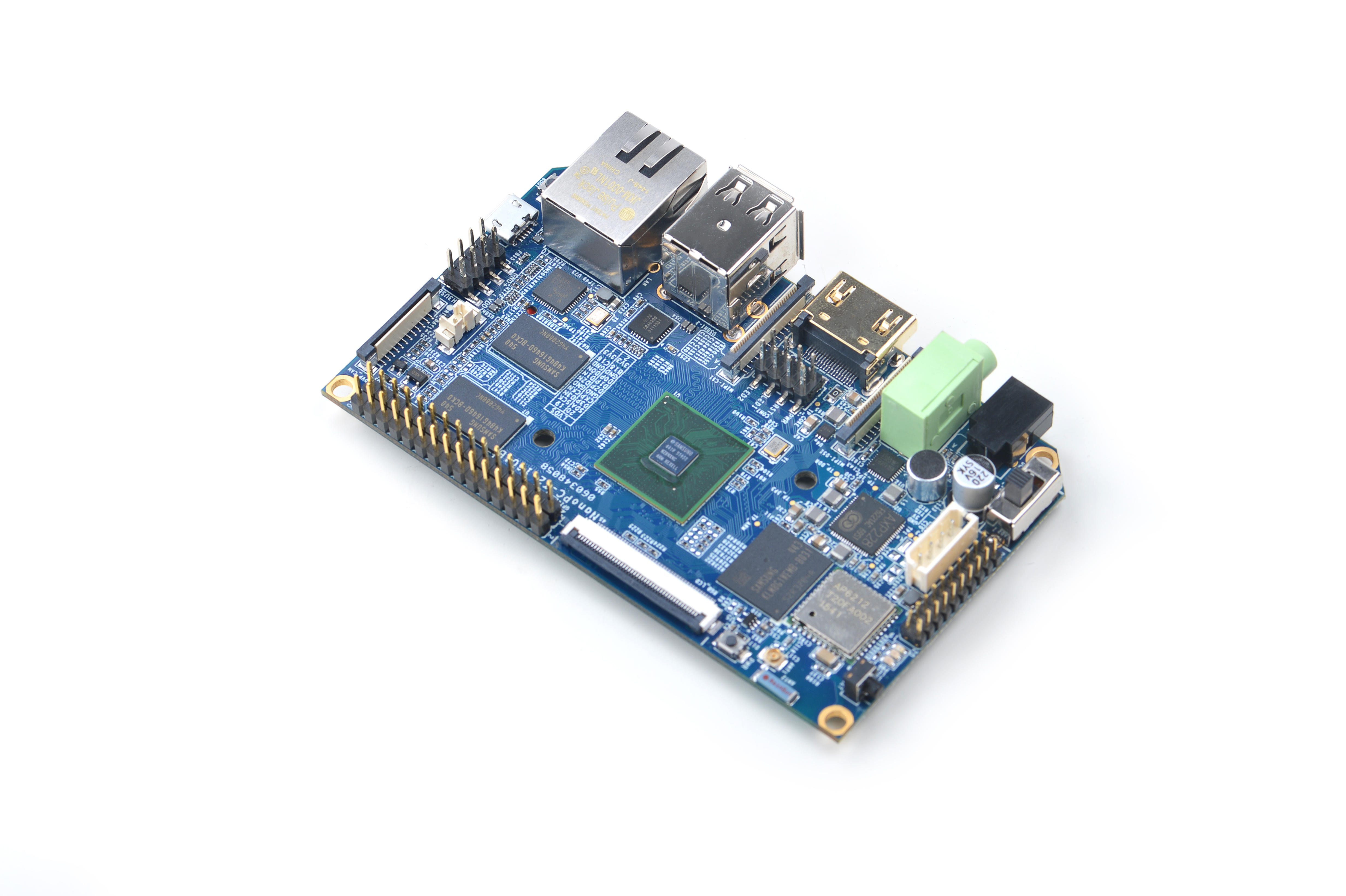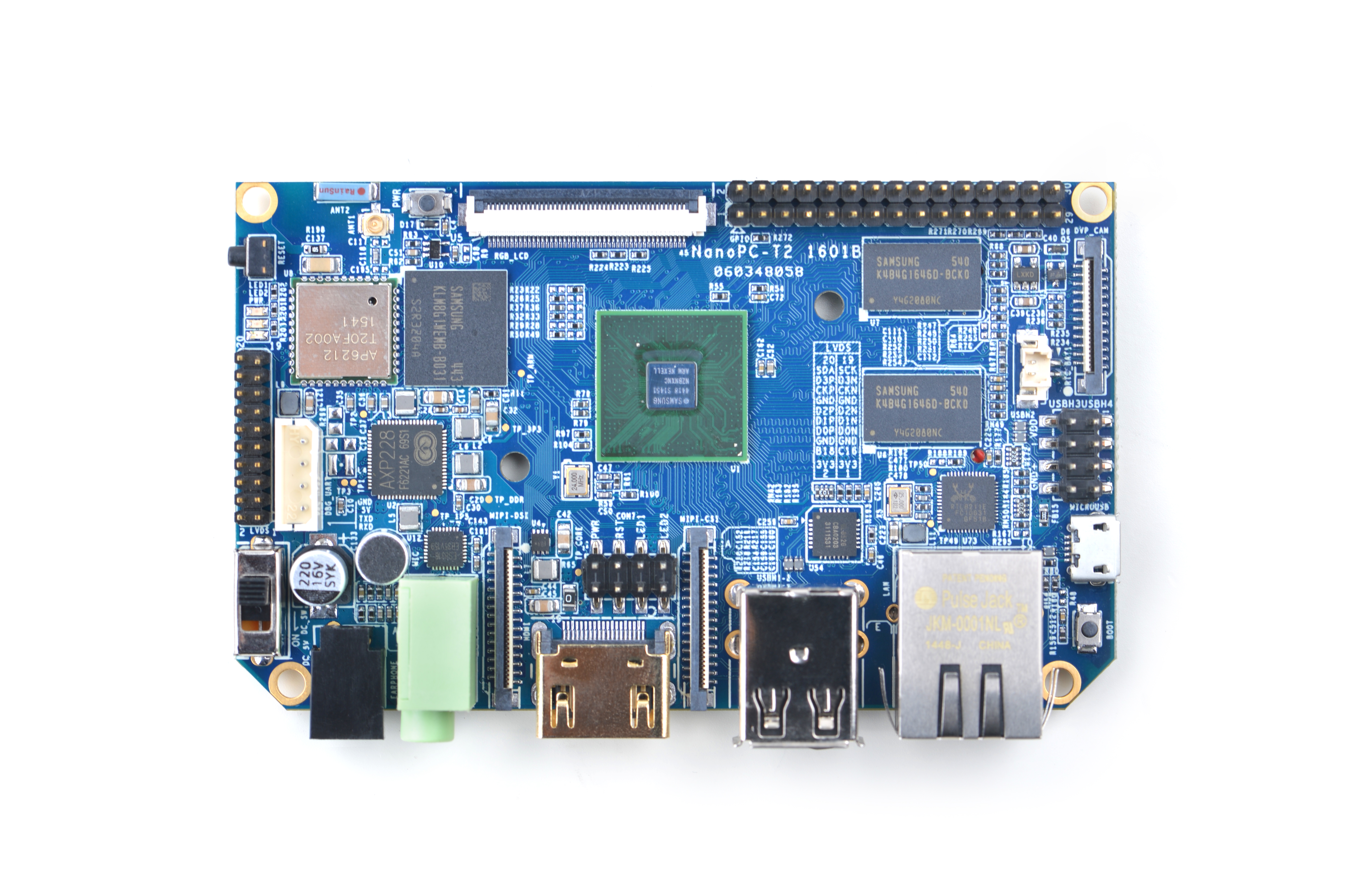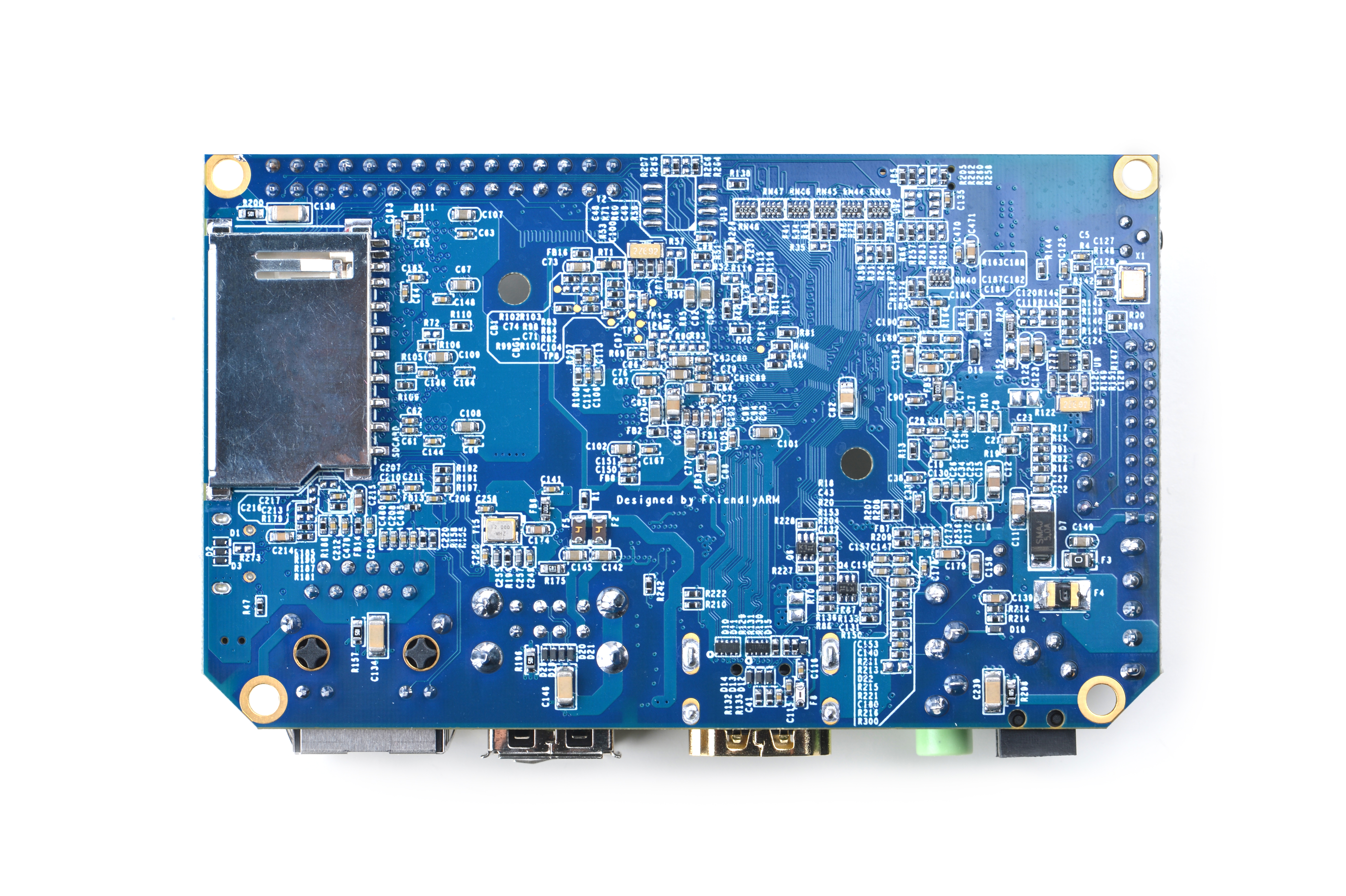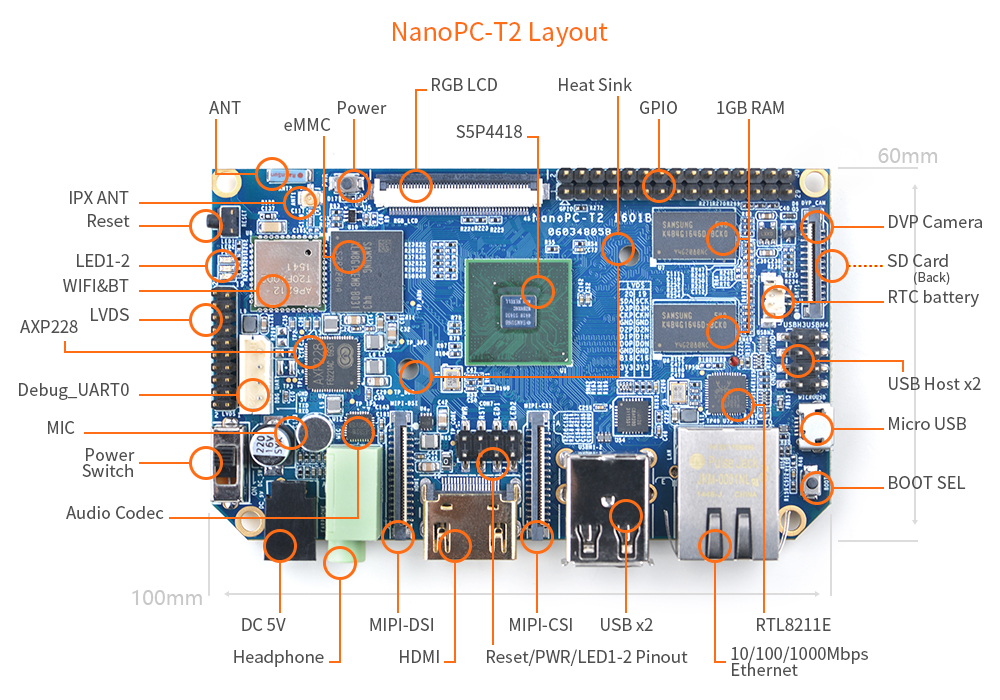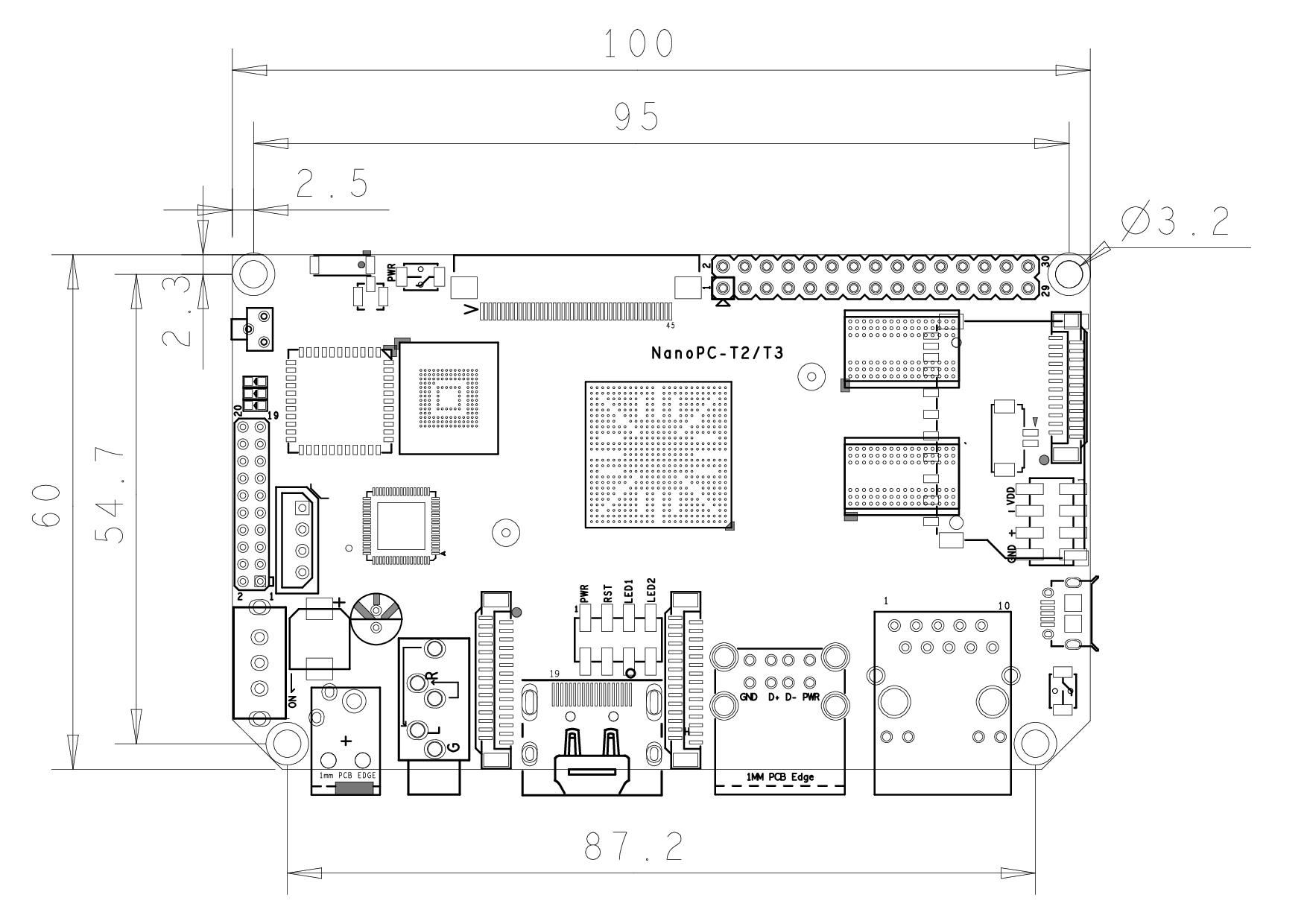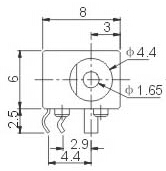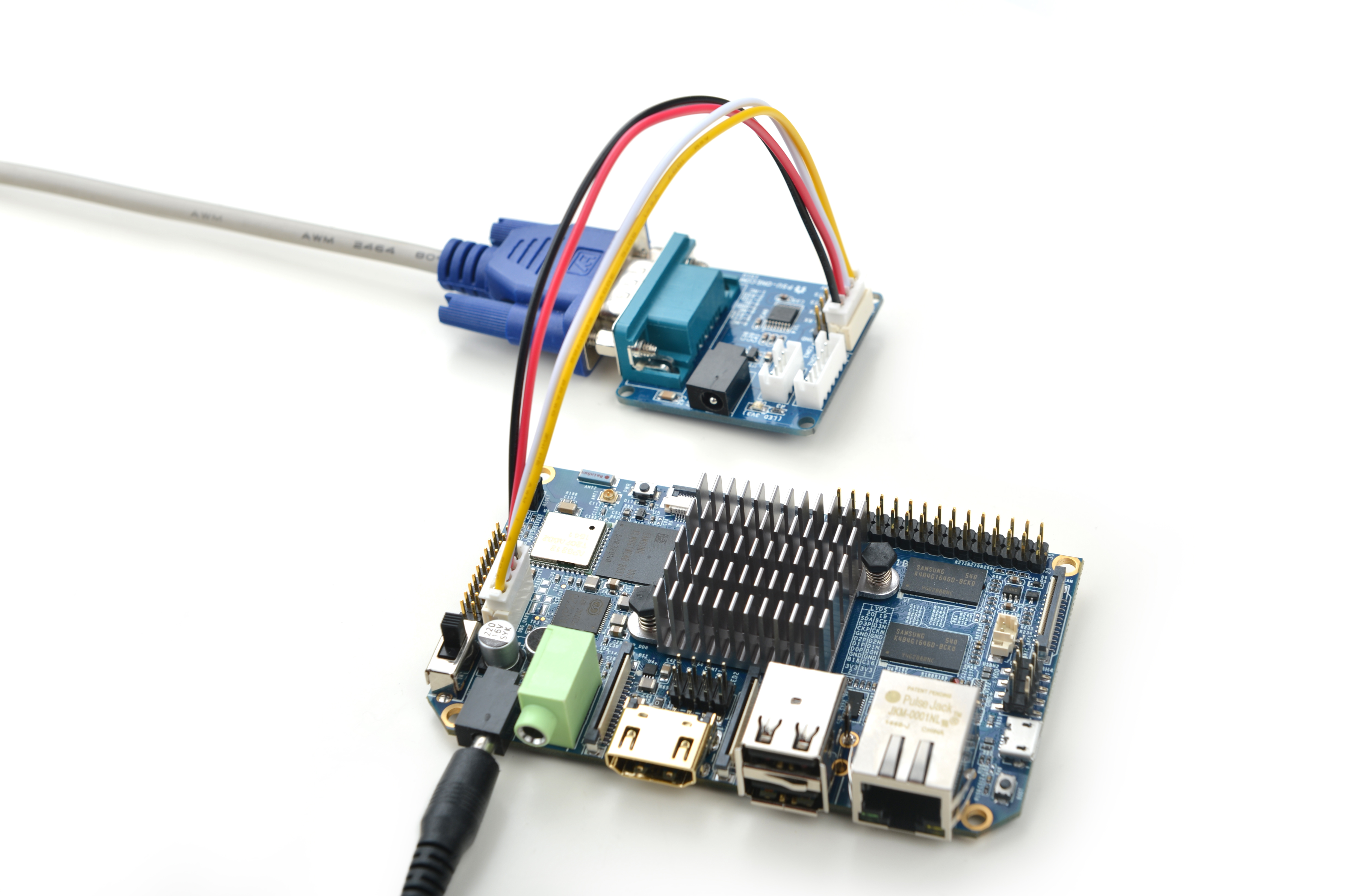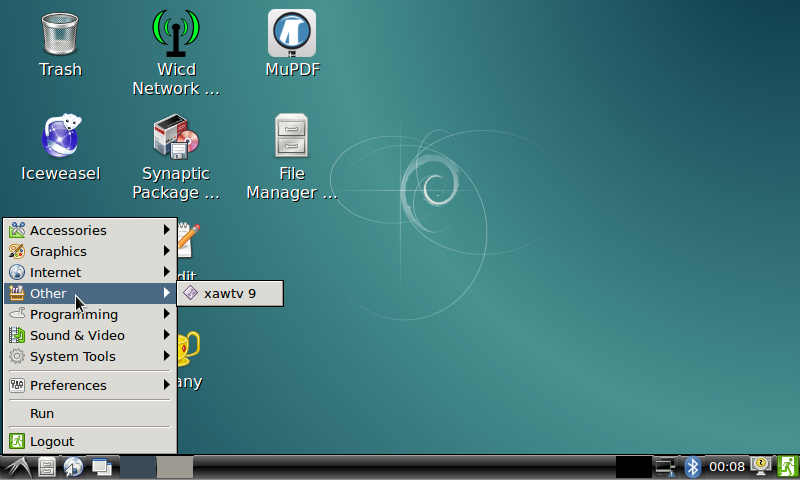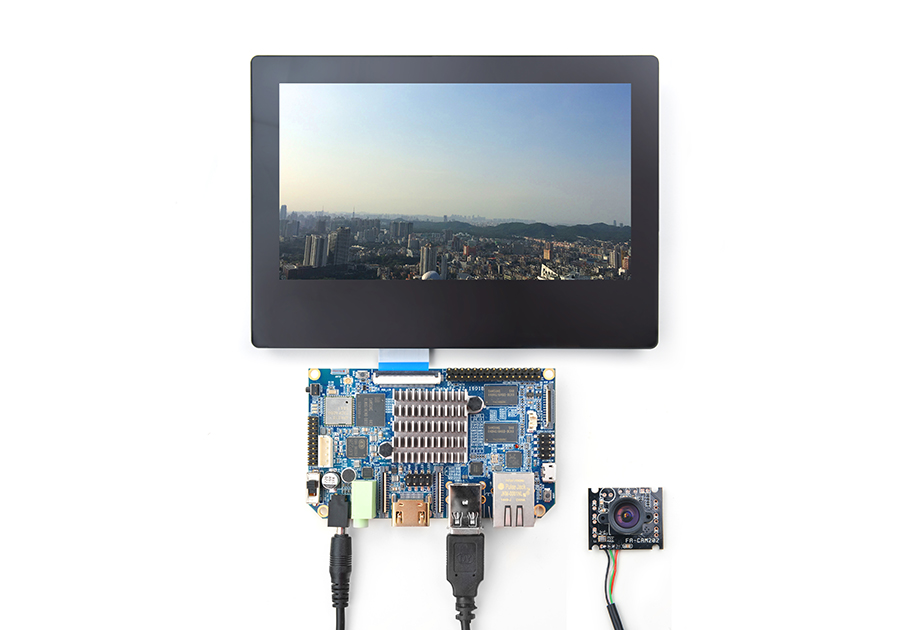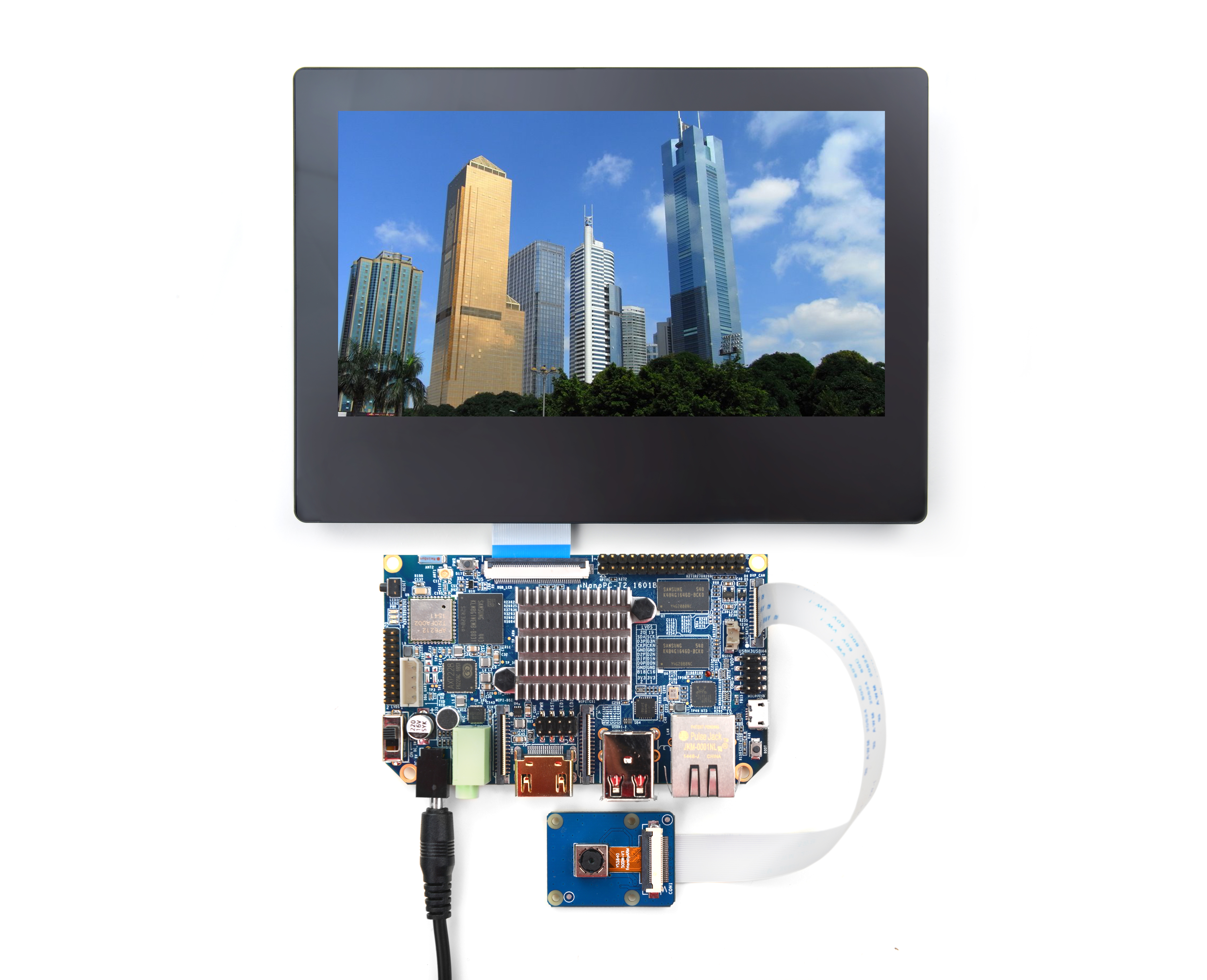Difference between revisions of "NanoPC-T2"
| Line 919: | Line 919: | ||
(Note: you need to replace "/dev/sdx" with the device name in your system) | (Note: you need to replace "/dev/sdx" with the device name in your system) | ||
---> | ---> | ||
| + | ===支持LCD型号=== | ||
| + | * Android | ||
| + | NanoPC-T2跑Android系统目前支持的LCD型号为友善出品的:S700、S702、HD700、HD101、X710电容屏。 | ||
| + | |||
| + | * Debian | ||
| + | NanoPC-T2跑Debian系统目前支持的LCD型号为友善出品的:S700、S702、HD700、HD101、X710电容屏;<br /> | ||
| + | 支持的电阻屏为友善出品的:W35B、P43、S70D、W101电阻屏。 | ||
| + | |||
| + | ==Android硬件库使用== | ||
| + | 在 NanoPi2/NanoPi M2/NanoPi2 Fire/NanoPC-T2 上,串口对应的设备名称如下: | ||
| + | UART2 -> 未驱动 | ||
| + | UART3 -> /dev/ttyAMA2 | ||
| + | UART4 -> /dev/ttyAMA3 | ||
| + | 硬件访问库 libfriendlyarm-hardware.so,可用于在Android下操作串口,并且有一个开源示例Demo,下载串口Demo: | ||
| + | <syntaxhighlight lang="bash"> | ||
| + | git clone https://github.com/friendlyarm/android_SerialPortDemo.git | ||
| + | </syntaxhighlight> | ||
| + | libfriendlyarm-hardware.so 库集成在Android rom里system/lib/libfriendlyarm-hardware.so下;<br /> | ||
| + | 并且可在Android下操作串口,I2C, SPI, GPIO等接口,并增加iTest测试程序,用户不需要root开发板(实际操作硬件和root无关),使用方法可参考采用相同接口的Tiny4412安卓编程文档:http://www.arm9home.net/read.php?tid-82748.html,二者API都是一致的。 | ||
| + | |||
| + | |||
| + | ==更多OS== | ||
| + | ===Ubuntu-Core with Qt-Embedded=== | ||
| + | Ubuntu Core with Qt-Embedded,是一个没有X-windows环境,使用Qt-Embedded作为图形界面的轻量级Ubuntu系统,基于官方的Ubuntu core系统开发而成,非常适合于企业用户用作产品的基础OS。 | ||
| + | |||
| + | 本系统除了保留Ubuntu core的特性以外,还包括以下特性: | ||
| + | *支持电容和电阻触摸屏 (型号:S700, X710, S70) | ||
| + | *支持WiFi连接 | ||
| + | *支持以太网连接 | ||
| + | *支持蓝牙,已预装bluez等相关软件包 | ||
| + | *支持音频播放 | ||
| + | *等等 | ||
| + | |||
| + | 请访问此处 [http://wiki.friendlyarm.com/wiki/index.php/Ubuntu_Core_with_Qt-Embedded Ubuntu Core with Qt-Embedded] 了解详情。<br /> | ||
| + | |||
| + | ====如何烧写Ubuntu-Core with Qt-Embedded到eMMC==== | ||
| + | 1、用Debian或者现在的UbuntuCore+Qt,用win32工具做好一张从SD卡启动卡;<br /> | ||
| + | 2、把做好的卡插进Linux系统电脑里,拷贝UbuntuCore到SD卡,还需要把2nboot也拷贝到SD卡里;<br /> | ||
| + | 3、使用dd命令:使用dd命令将第2步中从电脑拷贝的镜像(ubuntu_core.img)写入到NanoPC-T2的eMMC中: | ||
| + | <syntaxhighlight lang="bash"> | ||
| + | dd if=ubuntu_core.img of= /dev/mmcblk1 | ||
| + | </syntaxhighlight> | ||
| + | 4、使用dd命令将第3步中从电脑拷贝的2ndboot.bin.emmc写入到4418的emmc中: | ||
| + | <syntaxhighlight lang="bash"> | ||
| + | dd if=2ndboot.bin.emmc of=/dev/mmcblk1 bs=512 seek=1 | ||
| + | </syntaxhighlight> | ||
| + | |||
| + | ===Ubuntu-Mate=== | ||
| + | Ubuntu-Mate基于Ubuntu系统,使用的桌面环境是Mate-desktop,界面简洁易用,需配合LCD或者HDMI使用,可通过ssh登录。<br> | ||
| + | 仅提供给进阶爱好者交流使用,不对该系统提供专业技术支持。<br> | ||
| + | * 访问此处[http://pan.baidu.com/s/1boiCWWJ 下载地址]下载系统固件。 | ||
| + | * 将固件解压后,在Windows下使用友善官方提供 win32diskimager 工具烧写Ubuntu-Mate即可。 | ||
| + | * 烧写完成后,将SD卡插入NanoPi 2,上电即可体验Ubuntu-Mate。 | ||
| + | * 登录账号:root或fa ; 登录密码:fa | ||
| + | |||
| + | ===Kali=== | ||
| + | * 首先访问此处[http://pan.baidu.com/s/1o7i4846]的下载地址下载需要的固件文件; | ||
| + | * 准备大于8G的高速microSD卡(建议使用友善官方测试过的SD卡),并插入linux主机,通过命令sudo fdisk -l 查看该sd卡是哪个设备即/dev/sd*。 | ||
| + | * 下载后把文件写到卡里,使用超级用户权限执行下列命令: | ||
| + | <syntaxhighlight lang="bash"> | ||
| + | xzcat kali-2.0-nanopi2.img.xz | dd of=<YOURDEVICE> bs=1m | ||
| + | </syntaxhighlight> | ||
| + | * 烧写完成,将卡插入设备,上电即可开始体验Kali操作系统。 | ||
| + | * 登录账号:root ; 登录密码:toor | ||
| + | |||
| + | 说明:此文件系统是由Kali官方制作,我们仅提供下载链接供爱好者使用,不对此做技术支持。 | ||
| + | |||
| + | ===深度操作系统 15 ARM=== | ||
| + | * 首先访问此处[http://cdimage.deepin.com/armhf/15/beta1.0/]的下载地址下载需要的固件; | ||
| + | * 用文件,解压得到16g.img是microSD卡镜像文件。 | ||
| + | <syntaxhighlight lang="bash"> | ||
| + | tar -xf deepin15_nanopi2_armhf_16g.tar.gz | ||
| + | </syntaxhighlight> | ||
| + | * 准备好不小于16G的microSD卡,并插入linux主机,通过命令sudo fdisk -l 查看该sd卡是哪个设备即/dev/sd* | ||
| + | * 将镜像用dd命令刻录到microSD卡,我们假设microSD卡是 /dev/sdc(请根据实际情况判断,千万不要选错设备),那么用如下命令: | ||
| + | <syntaxhighlight lang="bash"> | ||
| + | sudo dd if=16g.img of=/dev/sdc | ||
| + | </syntaxhighlight> | ||
| + | |||
| + | (根据microSD卡的读写性能不同,烧写时间一般为40~60分钟) | ||
| + | |||
| + | * 烧写完成,将卡插入设备,上电即可开始体验deepin15操作系统 | ||
| + | |||
| + | |||
| + | 其他注意事项: | ||
| + | 1.登陆用户名deepin密码deepin,root密码admin。<br> | ||
| + | |||
| + | 2.烧写成功后,第一次启动,会有些配置文件产生,开机会比较慢。<br> | ||
| + | |||
| + | 3.如果系统开启无线网络功能,开机会较慢,请耐心等待任务栏右下角声音和无线模块出现后再进行其他操作,后期会继续优化。<br> | ||
| + | |||
| + | <syntaxhighlight lang="bash"> | ||
| + | ARM版仓库:http://packages.deepin.com/armhf/ | ||
| + | |||
| + | NanoPi 2镜像:http://cdimage.deepin.com/armhf/15/beta1.0/ | ||
| + | |||
| + | NanoPi 2镜像使用方法:http://bbs.deepin.org/forum.php?mod=viewthread&tid=36670 | ||
| + | |||
| + | ARM移植讨论:http://bbs.deepin.org/ | ||
| + | |||
| + | </syntaxhighlight> | ||
| + | |||
| + | 说明:此文件系统是由深度操作系统官方制作,我们仅提供下载链接供爱好者使用,不对此做技术支持。 | ||
| + | |||
| + | ===Android-Remixos=== | ||
| + | 首先访问[http://pan.baidu.com/s/1qYCbqDu]下载固件;<br> | ||
| + | 仅提供给进阶爱好者交流使用,不对该系统提供专业技术支持。<br> | ||
| + | * 用文件,解压得到镜像文件: | ||
| + | <syntaxhighlight lang="bash"> | ||
| + | tar -xf nanopi2-android-remixos-sd4g.tar | ||
| + | </syntaxhighlight> | ||
| + | * 将固件解压后,在Windows下使用友善官方提供 win32diskimager 工具烧写Android-Remixos即可。 | ||
| + | 该系统支持HDMI输出,LCD显示,并且同时支持友善出品的所有4418系列开发板。 | ||
==Source Code and Image Files Download Links== | ==Source Code and Image Files Download Links== | ||
Revision as of 15:22, 29 June 2016
Contents
- 1 Introduction
- 2 Features
- 3 Diagram, Layout and Dimension
- 4 Notes in Hardware Design
- 5 Get Started
- 6 Working with Debian
- 7 Make Your Own OS Image
- 8 Connect NanoPC-T2 to External Modules
- 9 Android硬件库使用
- 10 更多OS
- 11 Source Code and Image Files Download Links
- 12 Resources
- 13 Tech Support
- 14 Update Log
1 Introduction
- The NanoPC-T2 quad core Cortex A9 single board computer is designed and developed by FriendlyARM for professional and enterprise users. It uses the Samsung Quad Core Cortex-A9 S5P4418 SoC with dynamic frequency scaling up to 1.4GHz. Compared to FriendlyARM's existing 4418 based boards the NanoPC-T2 has 8G eMMC onboard, audio jack and video input/output interfaces. Compared to its predecessor the NanoPC-T1 the NanoPC-T2 has built-in WiFi, Bluetooth and Gbps Ethernet port. In addition the NanoPC-T2 has power management which the NanoPC-T1 doesn't support. To avoid overheat issues the NanoPC-T2 has a heat sink with mounting posts.
- The NanoPC-T2 combines all the ports and interfaces the existing FriendlyARM 4418 boards have. Currently it has the most interfaces and ports among all existing ARM boards of this size. Its rich video interfaces and support for HDMI 1080P enable it to work with not only popular display devices but also various FriendlyARM LCDs (both resistive touch and capacitive touch).
- The NanoPC-T2 is FriendlyARM's most complete solution based on Samsung 4418 for both commercial and industrial applications.
2 Features
- SoC: Samsung S5P4418 Quad Core Cortex-A9 with dynamic frequency scaling up to 1.4G Hz
- Power Management Unit: AXP228 PMU, it supports software power-off and wake-up.
- System Memory: 1GB 32bit DDR3 RAM
- eMMC: 8GB
- Storage: 1 x SD Card Slot
- Ethernet: Gbps Ethernet Port (RTL8211E) with unique MAC
- WiFi: 802.11b/g/n
- Bluetooth: 4.0 dual mode
- Antenna: Porcelain Antenna IPX Interface
- Video Input: DVP Camera/MIPI-CSI (two camera interfaces)
- Video Output: HDMI Type-A / LVDS / LCD / MIPI DSI (four video output interfaces)
- Audio: 3.5 mm audio jack / via HDMI
- Microphone: 1 x onboard Microphone
- USB: 4 x USB 2.0 Host, two standard type A ports and two 2.54mm pitch pin headers
- MicroUSB: 1 x MicroUSB 2.0 Client, Type A
- LCD Interface: 0.5mm pitch 45 pin FPC seat, full color RGB 8-8-8
- HDMI: 1.4A Type A, 1080P
- DVP Camera: 0.5mm pitch 24 pin FPC seat
- GPIO: 2.54 mm pitch 30 pin header
- Serial Debug Port: 2.54mm pitch 4pin header
- LED: 1 x power LED , 2 x GPIO LED
- User Key: 1 x K1 (power), 1 x Reset
- Other Resource: 1 x onboard thermistor
- RTC Battery: RTC Seat Pins
- Power: DC 5V/2A
- Heat Sink: 1 x Heat Sink with mounting holes
- PCB: Six Layer, ENIG
- PCB Dimension: 100 mm x 60 mm
- OS/Software: u-boot, Android5.1, Debian8
3 Diagram, Layout and Dimension
3.1 Layout
- 30Pin GPIO Pin Spec
Pin# Name Pin# Name 1 SYS_3.3V 2 DGND 3 UART2_TX/GPIOD20 4 UART2_RX/GPIOD16 5 I2C0_SCL 6 I2C0_SDA 7 SPI0_MOSI/GPIOC31 8 SPI0_MISO/GPIOD0 9 SPI0_CLK/GPIOC29 10 SPI0_CS/GPIOC30 11 UART3_TX/GPIOD21 12 UART3_RX/GPIOD17 13 UART4_TX/GPIOB29 14 UART4_RX/GPIOB28 15 GPIOB31 16 GPIOB30 17 GPIOC4 18 GPIOC7 19 GPIOC8 20 GPIOC24 21 GPIOC28 22 GPIOB26 23 GPIOD1/PWM0 24 GPIOD8/PPM 25 GPIOC13/PWM1 26 AliveGPIO3 27 GPIOC14/PWM2 28 AliveGPIO5 29 VDD_5V 30 DGND
- 20Pin LVDS Interface Pin Spec
Pin# Name Pin# Name 1 SYS_3.3V 2 SYS_3.3V 3 GPIOC16 4 GPIOB18 5 DGND 6 DGND 7 LVDS_D0- 8 LVDS_D0+ 9 LVDS_D1- 10 LVDS_D1+ 11 LVDS_D2- 12 LVDS_D2+ 13 DGND 14 DGND 15 LVDS_CLK- 16 LVDS_CLK+ 17 LVDS_D3- 18 LVDS_D3+ 19 I2C2_SCL 20 I2C2_SDA
- DVP Camera Interface Pin Spec
Pin# Name 1, 2 SYS_3.3V 7,9,13,15,24 DGND 3 I2C0_SCL 4 I2C0_SDA 5 GPIOB14 6 GPIOB16 8,10 NC 11 VSYNC 12 HREF 14 PCLK 16-23 Data bit7-0
- RGB LCD IF Pin Spec
Pin# Name Description 1, 2 VDD_5V 5V Output, it can be used to power LCD modules 11,20,29, 37,38,39,40, 45 DGND Ground 3-10 Blue LSB to MSB RGB blue 12-19 Green LSB to MSB RGB green 21-28 Red LSB to MSB RGB red 30 GPIOB25 available for users 31 GPIOC15 occupied by FriendlyARM one wire technology to recognize LCD models and control backlight and implement resistive touch, not applicable for users 32 XnRSTOUT Form CPU low when system is reset 33 VDEN signal the external LCD that data is valid on the data bus 34 VSYNC vertical synchronization 35 HSYNC horizontal synchronization 36 LCDCLK LCD clock, Pixel frequency 41 I2C2_SCL I2C2 clock signal, for capacitive touch data transmission 42 I2C2_SDA I2C2 data signal, for capacitive touch data transmission 43 GPIOC16 interrupt pin for capacitive touch, used with I2C2 44 NC Not connected
- MIPI-DSI Interface Pin Spec
Pin# Name 1, 2, 3 VDD_5V 4 DGND 5 I2C2_SDA 6 I2C2_SCL 7 DGND 8 GPIOC0 9 DGND 10 GPIOC1 11 DGND 12 GPIOA28 13 nRESETOUT 14, 15 DGND 16 MIPIDSI_DN3 17 MIPIDSI_DP3 18 DGND 19 MIPIDSI_DN2 20 MIPIDSI_DP2 21 DGND 22 MIPIDSI_DN1 23 MIPIDSI_DP1 24 DGND 25 MIPIDSI_DN0 26 MIPIDSI_DP0 27 DGND 28 MIPIDSI_DNCLK 29 MIPIDSI_DPCLK 30 DGND
- MIPI-CSI Interface Pin Spec
Pin# Name 1, 2 SYS_3.3V 3 DGND 4 I2C0_SDA 5 I2C0_SCL 6 DGND 7 SPI2_MOSI/GPIOC12 8 SPI2_MISO/GPIOC11 9 SPI2_CS/GPIOC10 10 SPI2_CLK/GPIOC9 11 DGND 12 GPIOB9 13 GPIOC2 14, 15 DGND 16 MIPICSI_DN3 17 MIPICSI_DP3 18 DGND 19 MIPICSI_DN2 20 MIPICSI_DP2 21 DGND 22 MIPICSI_DN1 23 MIPICSI_DP1 24 DGND 25 MIPICSI_DN0 26 MIPICSI_DP0 27 DGND 28 MIPICSI_DNCLK 29 MIPICSI_DPCLK 30 DGND
- Note:
- SYS_3.3V: 3.3V power output
- VDD_5V: 5V power input/output. The input range is 4.7V ~ 5.6V
- For more details refer to the document: NanoPC-T2_1601B_Schematic.pdf
3.2 Board Dimension
- For more details refer to the document: NanoPC-T2-Dimensions(dxf)
- Power Jack
4 Notes in Hardware Design
4.1 EEPROM
- The board has an EEPROM(model: 24AA025E48T-I/OT) with a unique MAC. This EEPROM is connected to I2C0 and its address is 0x51 therefore some EEPROM chips cannot be connected to I2C0 which will cause conflicts of addresses.
- In our tests these EEPROM chips cannot be connected to I2C0: 24C04, 24C08 and 24C16. There chips which we tested can be connected to I2C0: 24C01, 24C02 and 24C256
- For more details about EEPROM address issues refer to http://www.onsemi.com/pub_link/Collateral/CAT24C01-D.PDF
5 Get Started
5.1 Essentials You Need
Before starting to use your NanoPC-T2 get the following items ready
- NanoPC-T2
- SD Card: Class 10 or Above, minimum 8GB SDHC
- A DC 5V/2A power is a must
- HDMI monitor or LCD
- USB keyboard, mouse and possible a USB hub(or a TTL to serial board)
- A host computer running Ubuntu 14.04 64 bit system
5.2 Make an Installation SD Card
5.2.1 Boot NanoPC-T2 from SD Card
Get the following files from here download link:
- Get a 4G SDHC card and backup its data if necessary.
For LCD or HDMI output use the following files: nanopi2-debian-sd4g.img.zip Debian image files (there two Debian files) nanopi2-android-sd4g.img.zip Android image files Flash Utility: win32diskimager.rar Windows utility. Under Linux users can use "dd"
- Uncompress these files. Insert an SD card(at least 4G) into a Windows PC and run the win32diskimager utility as administrator. On the utility's main window select your SD card's drive, the wanted image file and click on "write" to start flashing the SD card.
- Insert this card into your NanoPC-T2's boot slot, press and hold the boot key and power on (with a 5V/2A power source). If the PWR LED is on and LED1 is blinking this indicates your NanoPC-T2 has successfully booted.
5.2.2 Boot NanoPC-T2 from eMMC
- Download RAW Image
Get the image file: nanopi2-eflasher-sd4g.img.zip and the Windows utility: win32diskimager.rar;
- Flash RAW Image to SD Card
Insert an SD card(at least 4G) into a Windows PC and run the win32diskimager utility as administrator. On the utility's main window select your SD card's drive, the wanted image file and click on "write" to start flashing the SD card
- Prepare RAW image
Go to this link [1] to download Android and Debian image files(System-image-files-for-eMMC). After download untar the ".tgz" ball and copy the files to your SD card.
OS Image Files Copy to... Android 5.1 android-lollipop-images.tgz
android-lollipop-images.tgz.hash.md5boot.img
system.img
userdata.img
cache.img
partmap.txt
images\android Debian (Jessie) debian-jessie-images.tgz
debian-jessie-images.tgz.hash.md5boot.img
rootfs.img
partmap.txt
images\debian
- Specify OS
By default the SD card's configuration file "images\FriendlyARM.ini" specifies Android to be flashed to eMMC. If you want to install Debian make the following change:
OS = Debian
"#" is a comment
- Flash Image to NanoPC-T2's eMMC
Insert this card into your NanoPC-T2, connect the board to an HDMI monitor or an LCD, press and hold the boot key and power on (with a 5V/2A power source) the board to start installation. You can watch the whole installation process from the HDMI monitor or LCD. If the following messages pop up it means the installation has succeeded.
Android is fused successfully. All done.
After installation is done do "reset" or power off and on the board to boot the board from eMMC.
- You can check the LED's status to monitor the installation process too
LED Status Installation Status LED1 blinks twice continuously
LED2 offPower on normal.
If installation doesn't proceed LED1 will keep behaving this way and LED2 will be offLED1 and LED2 blink alternatively with each blink for 0.3s Installation proceeding LED1 and LED2 blink alternatively with each blink for 1.2s Installation succeeded LED1 and LED2 blink simultaneously Installation failed
5.2.3 Make Installation Card under Linux Desktop
- 1) Insert your SD card into a host computer running Ubuntu and check your SD card's device name
dmesg | tail
Search the messages output by "dmesg" for similar words like "sdc: sdc1 sdc2". If you can find them it means your SD card has been recognized as "/dev/sdc". Or you can check that by commanding "cat /proc/partitions"
- 2) Downlaod Linux script
git clone https://github.com/friendlyarm/sd-fuse_nanopi2.git cd sd-fuse_nanopi2
- 3) Make Android SD Card
su ./fusing.sh /dev/sdx
(Note: you need to replace "/dev/sdx" with the device name in your system)
When you run the script for the first time it will prompt you to download an image you have to hit “Y” within 10 seconds otherwise you will miss the download
- 4) Here is how to make a Debian SD card
./fusing.sh /dev/sdx debian
5.2.4 Extend NanoPC-T2's SD Card Section
- When Debian/Ubuntu is loaded the SD card's section will be automatically extended.
- When Android is loaded you need to run the following commands on your host PC to extend your SD card's section:
sudo umount /dev/sdx? sudo parted /dev/sdx unit % resizepart 4 100 resizepart 7 100 unit MB print sudo resize2fs -f /dev/sdx7
(Note: you need to replace "/dev/sdx" with the device name in your system)
5.2.5 LCD/HDMI Resolution
When the system boots our uboot will check whether it is connected to an LCD or to an HDMI monitor. If it recognizes an LCD it will configure its resolution. Our uboot defaults to the HDMI 720P configuration.
If you want to modify the LCD resolution you can modify file "arch/arm/plat-s5p4418/nanopi2/lcds.c" in the kernel and recompile it.
If your NanoPC-T2 is connected to an HDMI monitor and it runs Android it will automatically set the resolution to an appropriate HDMI mode by checking the "EDID". If your NanoPC-T2 is connected to an HDMI monitor and it runs Debian by default it will set the resolution to the HDMI 720P configuration. If you want to modify the HDMI resolution to 1080P modify your kernel's configuration as explained above.
5.3 Update Image Files in SD Card From PC Host
If you want to make some changes to the image files in your SD card follow the steps below otherwise you can skip this section.
Insert your SD card into a host PC running Linux, mount the boot and rootfs sections of the SD card and follow the steps below:
1) If you want to change your kernel command line parameters you can do it via the fw_setevn utility under "sd-fuse_nanopi2/tools".
Check the current Command Line:
cd sd-fuse_nanopi2/tools ./fw_printenv /dev/sdc | grep bootargs
Android 5.1.1_r6 starts SELinux. By default it is enforcing. You can change it this way:
./fw_setenv /dev/sdc bootargs XXX androidboot.selinux=permissive
This sets it to "permissive". The "XXX" stands for the original bootargs' value.
2) Update Kernel
Our customized uboot will check the LCD type when it boots.
For a non-Android OS if it recognizes that an LCD is connected to the NanoPC-T2 it will load "uImage" from "boot" otherwise it will load "uImage.hdmi".
For Android it doesn't make any difference which display device is detected. You can use your generated uImage to replace the existing one under "boot".
For Debian if your generated kernel is for an LCD you need to replace the existing uImage or if your kernel is for an HDMI monitor you need to replace the existing uImage.hdmi.
5.4 Run Android or Debian
- Insert an SD card with Android/Debian image file into your NanoPC-T2, connect the board to an HDMI monitor, press and hold the boot key, power on the board the NanoPC-T2 will boot from the SD card. If you can see the PWR LED on and the LED1 flashing it means your board is working and you will see Android/Debain being loaded on the HDMI monitor.
1)If you connect the NanoPC-T2 to an HDMI monitor you need to use a USB mouse and a USB keyboard to operate. If you connect it to an LCD with capacitive touch you can operate directly on the LCD.
2)If you want to do kernel development you need to use a serial communication board, ie a PSU-ONECOM board, which will allow you to operate the board via a serial terminal.
- Here is a setup where we connect a NanoPC-T2 to a PC running Ubuntu and Minicom via a serial cable you will see system messages output to the PC’s minicom terminal:
- Under Debian the password for "root" is "fa"
5.5 Login to Debian via VNC or SSH
If your NanoPC-T2 is not connected to a display device and your board runs the "-wifiap.img" image you can login to your NanoPC-T2's nanopi2-wifiap(the default password is "123456789") via a mobile phone. You can download and install a "VNC Viewer" from here on a mobile phone and login to the NanoPC-T2 via VNC. Its default password is "fa123456".
Here is a screenshot which shows how it looks like when users login to the NanoPC-T2 from an iPhone via VNC:

You can login via "SSH -l root 192.168.8.1" the default password for "root" is "fa"
To make SSH session run faster turn off the WiFi's power saving mode by using the following command:
iwconfig wlan0 power off
6 Working with Debian
6.1 Ethernet Connection
- If the NanoPC-T2 is connected to a network via Ethernet before it is powered on, it will automatically obtain an IP after it is powered up.
6.2 Wireless Connection
用vi或在图形界面下用gedit编辑文件 /etc/wpa_supplicant/wpa_supplicant.conf, 在文件末尾填入路由器信息如下所示:
network={ ssid="YourWiFiESSID" psk="YourWiFiPassword" }
其中,YourWiFiESSID和YourWiFiPassword请替换成你要连接的无线AP名称和密码。
保存退出后,执行以下命令即可连接WiFi:
ifdown wlan0 ifup wlan0
如果你的WiFi密码中有特殊字符,或者你不希望明文存放密码,你可以使用wpa_passphrase命令为WiFi密码生成一个密钥(psk),用密钥来代替密码 ,在命令行下,可输入以下命令生成密钥:
wpa_passphrase YourWiFiESSID
在提示输入密码时,输入你的WiFi密码,再打开 /etc/wpa_supplicant/wpa_supplicant.conf 文件你会发现密钥已经被更新,你可以删除明文的密码了。
如果你的WiFi当前处于无线热点模式,你需要先退出该模式方可连接到路由器,使用以下命令退出无线热点模式:
su
turn-wifi-into-apmode no6.3 Setup Wi-Fi AP
You can follow the steps below to setup Wi-Fi AP:
turn-wifi-into-apmode yesReboot the system as prompted. By default the AP's name is "nanopi2-wifiap" and the password is 123456789.
Now you are able to find the "nanopi2-wifiap" from a host PC and connect to it. If a connection is successful you will be able to SSH to this NanoPC-T2 at "192.168.8.1":
ssh root@192.168.8.1
The password for it is "fa"
To make SSH session run faster turn off the WiFi's power saving mode by using the following command:
iwconfig wlan0 power off
You can check the WiFi mode via the following command:
cat /sys/module/bcmdhd/parameters/op_mode
If the result is "2" it means it is currently working as a WiFi AP.If you want to switch back to the Station mode you can do it this way:
turn-wifi-into-apmode no
6.4 Bluetooth
执行以下名安装蓝牙APP:
apt-get install blueman安装后,重启开发板,点击右下角的蓝牙图标,会弹出一个操作菜单,其中,
Make discoverable菜单项是打开NanoPC-T2蓝牙的可发现属性,这样其他设备(例如手机)就可以搜索到NanoPC-T2并进行配对了;
Devices... 菜单项可以打开搜索界面,主动搜索周边的蓝牙设备(注:需要这个设备先打开可发现属性);
Send Files to Device...菜单项则可以通过蓝牙发送文件到已配对的指定设备上。
6.5 Install Debian Packages
We provide a Debian Jessie image. You can install Jessie's packages by commanding "apt-get". If this is your first installation you need to update the package list by running the following command
apt-get updateYou can install your preferred packages. For example if you want to install an FTP server you can do this:
apt-get install vsftpdNote: you can change your download server by editting "/etc/apt/sources.list". You can get a complete server list from [2]. You need to select the one with "armhf".
7 Make Your Own OS Image
7.1 Install Cross Compiler
Download the compiler package:
git clone https://github.com/friendlyarm/prebuilts.git sudo mkdir -p /opt/FriendlyARM/toolchain sudo tar xf prebuilts/gcc-x64/arm-cortexa9-linux-gnueabihf-4.9.3.tar.xz -C /opt/FriendlyARM/toolchain/
Then add the compiler's directory to "PATH" by appending the following lines in "~/.bashrc":
export PATH=/opt/FriendlyARM/toolchain/4.9.3/bin:$PATH export GCC_COLORS=auto
Execute "~/.bashrc" to make the changes take effect. Note that there is a space after the first ".":
. ~/.bashrcThis compiler is a 64-bit one therefore it cannot be run on a 32-bit Linux machine. After the compiler is installed you can verify it by running the following commands:
arm-linux-gcc -v Using built-in specs. COLLECT_GCC=arm-linux-gcc COLLECT_LTO_WRAPPER=/opt/FriendlyARM/toolchain/4.9.3/libexec/gcc/arm-cortexa9-linux-gnueabihf/4.9.3/lto-wrapper Target: arm-cortexa9-linux-gnueabihf Configured with: /work/toolchain/build/src/gcc-4.9.3/configure --build=x86_64-build_pc-linux-gnu --host=x86_64-build_pc-linux-gnu --target=arm-cortexa9-linux-gnueabihf --prefix=/opt/FriendlyARM/toolchain/4.9.3 --with-sysroot=/opt/FriendlyARM/toolchain/4.9.3/arm-cortexa9-linux-gnueabihf/sys-root --enable-languages=c,c++ --with-arch=armv7-a --with-tune=cortex-a9 --with-fpu=vfpv3 --with-float=hard ... Thread model: posix gcc version 4.9.3 (ctng-1.21.0-229g-FA)
7.2 Compile U-Boot
Download the U-Boot source code and compile it. Note that the github's branch is nanopi2-lollipop-mr1:
git clone https://github.com/friendlyarm/uboot_nanopi2.git cd uboot_nanopi2 git checkout nanopi2-lollipop-mr1 make s5p4418_nanopi2_config make CROSS_COMPILE=arm-linux-
After your compilation succeeds a u-boot.bin will be generated. If you want to test it flash it to your installation SD card via fastboot. Here is how you can do it:
1) On your host PC run "sudo apt-get install android-tools-fastboot" to install the fastboot utility;
2) Connect your NanoPC-T2 to your host PC via a serial cable (e.g. PSU-ONECOME). Press the enter key within two seconds right after you power on your NanoPC-T2 and you will enter uboot's command line mode;
3) After type in "fastboot" and press "enter" you will enter the fastboot mode;
4) Connect your NanoPC-T2 to this host PC via a microUSB cable and type in the following command to flash u-boot.bin:
fastboot flash bootloader u-boot.bin
Warning: you cannot update this SD card by commanding "dd". This command will cause trouble when booting the NanoPC-T2.
7.3 Prepare mkimage
You need the mkimage utility to compile a U-Boot source code package. Make sure this utility works well on your host before you start compiling a uImage.
You can install this utility by either commanding "sudo apt-get install u-boot-tools" or following the commands below:
cd uboot_nanopi2 make CROSS_COMPILE=arm-linux- tools sudo mkdir -p /usr/local/sbin && sudo cp -v tools/mkimage /usr/local/sbin
7.4 Compile Linux Kernel
7.4.1 Compile Kernel
- Download Kernel Source Code
git clone https://github.com/friendlyarm/linux-3.4.y.git cd linux-3.4.y git checkout nanopi2-lollipop-mr1
The NanoPC-T2's kernel source code lies in the "nanopi2-lollipop-mr1" branch.
- Compile Android Kernel
make nanopi2_android_defconfig touch .scmversion make uImage
- Compile Debian Kernel
make nanopi2_linux_defconfig touch .scmversion make uImage
After your compilation succeeds a uImage will be generated in the "arch/arm/boot/uImage" directory. This kernel is for HDMI 720P. You can use it to replace the existing uImage.hdmi.
If you want to generate a kernel for HDMI 1080P you can do it this way:
touch .scmversion make nanopi2_linux_defconfig make menuconfig Device Drivers --> Graphics support --> Nexell Graphics --> [ ] LCD [*] HDMI (0) Display In [0=Display 0, 1=Display 1] Resolution (1920 * 1080p) ---> make uImage
After your compilation succeeds a uImage will be generated for HDMI 1080P. You can use it to replace the existing uImage.
7.4.2 User Your Generated Kernel
- Update the kernel file in SD card
If you use an SD card to boot Android you can copy your generated uImage file to your SD card's boot section(e.g. section 1 /dev/sdX1).
If you use an SD card to Debian and you generated a uImage for an HDMI monitor you can use that uImage to replace the uImage.hdmi file in the SD card's boot section. If you use an SD card to Debian and you generated a uImage for an LCD you can use that uImage to replace the uImage file in the SD card's boot section.
- Update Android kernel file in eMMC
If you want to update the kernel file in eMMC you need firstly boot your board, then mount eMMC's boot section, replace the boot section's kernel file with your generated one and reboot your board to make your new kernel run.
If you boot your board from eMMC you can update your kernel file by following the steps below:
1) After Android is loaded mount eMMC's boot section (in our example eMMC's device name was /dev/mmcblk0p1) by using the following commands:
su mount -t ext4 /dev/block/mmcblk0p1 /mnt/media_rw/sdcard1/
2) Connect your board to a host PC running Ubuntu and copy the uImage file to eMMC's boot section by running the following commands
adb push uImage /mnt/media_rw/sdcard1/
3) Or you can copy your generated kernel file to an external storage card(e.g. an SD card or a USB drive), connect the storage card to your board the move the file from the card to eMMC's boot section
4) After update is done type in "reboot" to reload Android. Note don't directly power off and on the board or press the reset button to reboot the board. These two actions will damage your kernel file
- Update Debian kernel file in eMMC
If you boot your board from eMMC you can update your kernel file by following the steps below:
1) When Debian is being loaded eMMC's boot section will be automatically mounted(in our example eMMC's device name was /dev/mmcblk0p1). You can use "mount" to verify that
2) Connect your board to a host PC via Ethernet and copy your generated uImage file via scp/ftp to eMMC's boot section and replace the existing file. If your file is for an LCD use your uImage file to replace the existing uImage. If your file is for an HDMI monitor use your uImage.hdmi file to replace the existing uImage.hdmi file
3) Or you can copy your generated kernel file to an external storage card(e.g. an SD card or a USB drive), connect the storage card to your board the move the file from the card to eMMC's boot section
4) After update is done type in "reboot" to reload Debian. Note don't directly power off and on the board or press the reset button to reboot the board. These two actions will damage your kernel file
- Generate Your boot.img
If you want to generate an image file that can be flashed to eMMC you need to generate a boot.img file and copy it to your installation SD card
For Android copy the uImage file to Android source code's "device/friendly-arm/nanopi2/boot/" directory and compile this whole Android source code. After your compilation is successful you will get a boot.img file.
For Debian follow the steps below to generate a boot.img file
1) Download debian_nanopi2
git clone https://github.com/friendlyarm/debian_nanopi2.git
2) Copy the image file for an HDMI monitor and use it to replace the "debian_nanopi2/boot/uImage.hdmi" file and copy the image file for an LCD and use it to replace the "debian_nanopi2/boot/uImage" file
3) Generate Debian's boot.img
cd debian_nanopi2 mkdir rootfs ./build.sh
A newly generated boot.img will be under the "debian_nanopi2/sd-fuse_nanopi2/debian" directory.
The "mkdir rootfs" command creates a working directory for the build.sh script to run. It also creates some files such as "rootfs.img" but these files are useless.
7.4.3 Compile Kernel Modules
Android contains kernel modules which are in the "/lib/modules" directory in the system section. If you want to add your own modules to the kernel or you changed your kernel configurations you need to recompile these new modules.
Compile Original Kernel Modules:
cd linux-3.4.y make CROSS_COMPILE=arm-linux- modules
Here we have two new modules and we can compile them by following the commands below:
cd /opt/FriendlyARM/s5p4418/android ./vendor/friendly-arm/build/common/build-modules.sh
The "/opt/FriendlyARM/s5p4418/android" directory points to the top directory of Android source code. You can get more details by specifying option "-h".
After your compilation succeeds new modules will be generated
7.5 Compile Android
- Install Cross Compiler
Install 64 bit Ubuntu 14.04 on your host PC.
sudo apt-get install bison g++-multilib git gperf libxml2-utils make python-networkx zip sudo apt-get install flex libncurses5-dev zlib1g-dev gawk minicom
For more details refer to https://source.android.com/source/initializing.html 。
- Download Source Code
You need to use repo to get the Android source code. Refer to https://source.android.com/source/downloading.html 。
mkdir android && cd android repo init -u https://github.com/friendlyarm/android_manifest.git -b nanopi2-lollipop-mr1 repo sync
The "android" directory is the working directory.
- Compile System Package
source build/envsetup.sh lunch aosp_nanopi2-userdebug make -j8
After your compilation succeeds the following files will be generated in the "out/target/product/nanopi2/" directory.
filename partition Description boot.img boot - cache.img cache - userdata.img userdata - system.img system - partmap.txt - 分区描述文件
- Flash Image to eMMC
After compiling Android successfully you can flash it to eMMC with either of the following methods
1) fastboot: right after the NanoPC-T2 is booted from eMMC press any key to enter the uboot commandline mode and type in "fastboot"
Connect your board to a host PC running Ubuntu with a USB cable and run the following commands in the PC's terminal:
cd out/target/product/nanopi2 sudo fastboot flash boot boot.img sudo fastboot flash cache cache.img sudo fastboot flash userdata userdata.img sudo fastboot flash system system.img sudo fastboot reboot
2) Use an SD Card
Copy these files: boot.img, cache.img, userdata.img, system.img, partmap.txt from the out/target/product/nanopi2 directory to your installation SD card's images/android directory and you can use this SD card to flash Android to eMMC
8 Connect NanoPC-T2 to External Modules
8.1 Connect NanoPC-T2 to USB Camera(FA-CAM202)
- In this use case the NanoPC-T 2 runs Debian. If you connect your NanoPC-T2 to our LCD or an HDMI monitor after Debain is fully loaded click on "other"-->"xawtv" on the left bottom of the GUI and the USB Camera application will be started. After enter "welcome to xawtv!" click on "OK" to start exploring.
8.2 Connect NanoPC-T2 to CMOS 5M-Pixel Camera
- In this use case the NanoPC-T2 runs Android5.1. If you connect your NanoPC-T2 to our LCD or an HDMI monitor after Android is fully loaded click on the "Camera" icon and the application will be started.
8.3 Use OpenCV to Access USB Camera
- The full name of "OpenCV" is Open Source Computer Vision Library and it is a cross platform vision library.
- When the NanoPC-T2 runs Debian users can use OpenCV APIs to access a USB Camera device.
1. Here is a guideline on how to use OpenCV with C++ on the NanoPC-T2:
- Firstly you need to make sure your NanoPC-T2 is connected to the internet.Login to your NanoPC-T2 via a serial terminal or SSH. After login type in your username(root) and password(fa):
- Run the following commands:
apt-get update apt-get install libcv-dev libopencv-dev
2. Make sure your USB camera works with the NanoPC-T2. You can test your camera with NanoPC-T2's camera utility.
3. Check your camera device:
ls /dev/video*
- Note:in our test case video0 was the device name.
4. OpenCV's code sample(official code in C++) is under /home/fa/Documents/opencv-demo. Compile the code sample with the following commands:
cd /home/fa/Documents/opencv-demo make
After it is compiled successfully a "demo" executable will be generated
5. Connect NanoPC-T2 to USB Keyboard & Run the Following Command:
./demo8.4 Connect NanoPC-T2 to Matrix GPS Module
- The Matrix-GPS module is a small GPS module with high performance. It can be used in navigation devices, four-axle drones and etc.
- The Matrix-GPS module uses serial communication. When the NanoPC-T2 is connected to the Matrix GPS module, after the NanoPC-T2 is powered up type in the following command in a terminal or click on the xgps icon it will be started.
$su - fa -c "DISPLAY=:0 xgps 127.0.0.1:9999"
- Or on the Debian GUI start the LXTerminal, type in "xgps" and enter it will be started too.
For more details about this GPS module refer to this link
Refer to the following diagram to connect the NanoPC-T2 to the Matrix-GPS:
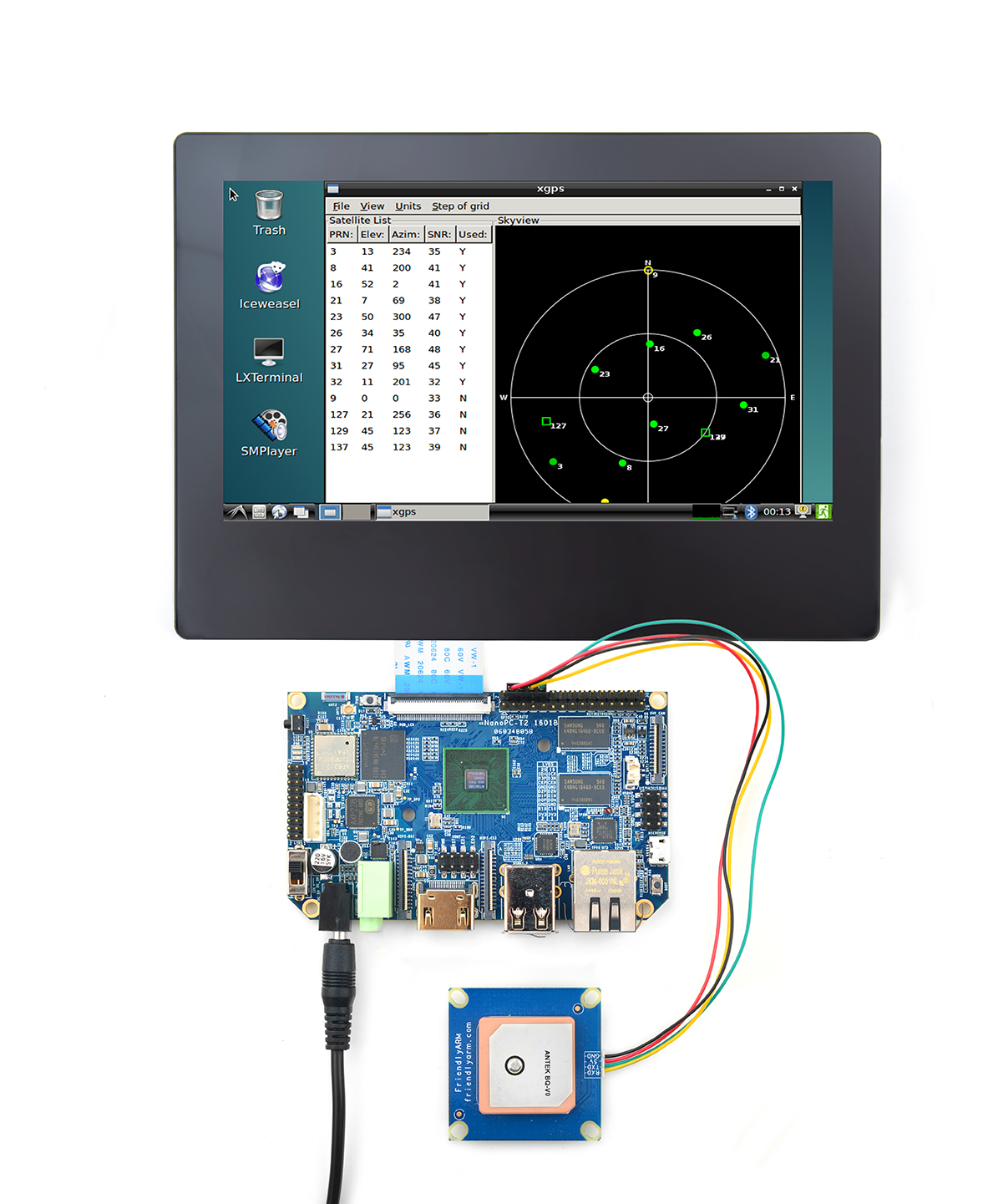
Connection Details:
| Matrix-GPS | NanoPC-T2 |
| RXD | Pin11 |
| TXD | Pin12 |
| 5V | Pin29 |
| GND | Pin30 |
8.5 支持LCD型号
- Android
NanoPC-T2跑Android系统目前支持的LCD型号为友善出品的:S700、S702、HD700、HD101、X710电容屏。
- Debian
NanoPC-T2跑Debian系统目前支持的LCD型号为友善出品的:S700、S702、HD700、HD101、X710电容屏;
支持的电阻屏为友善出品的:W35B、P43、S70D、W101电阻屏。
9 Android硬件库使用
在 NanoPi2/NanoPi M2/NanoPi2 Fire/NanoPC-T2 上,串口对应的设备名称如下:
UART2 -> 未驱动 UART3 -> /dev/ttyAMA2 UART4 -> /dev/ttyAMA3
硬件访问库 libfriendlyarm-hardware.so,可用于在Android下操作串口,并且有一个开源示例Demo,下载串口Demo:
git clone https://github.com/friendlyarm/android_SerialPortDemo.git
libfriendlyarm-hardware.so 库集成在Android rom里system/lib/libfriendlyarm-hardware.so下;
并且可在Android下操作串口,I2C, SPI, GPIO等接口,并增加iTest测试程序,用户不需要root开发板(实际操作硬件和root无关),使用方法可参考采用相同接口的Tiny4412安卓编程文档:http://www.arm9home.net/read.php?tid-82748.html,二者API都是一致的。
10 更多OS
10.1 Ubuntu-Core with Qt-Embedded
Ubuntu Core with Qt-Embedded,是一个没有X-windows环境,使用Qt-Embedded作为图形界面的轻量级Ubuntu系统,基于官方的Ubuntu core系统开发而成,非常适合于企业用户用作产品的基础OS。
本系统除了保留Ubuntu core的特性以外,还包括以下特性:
- 支持电容和电阻触摸屏 (型号:S700, X710, S70)
- 支持WiFi连接
- 支持以太网连接
- 支持蓝牙,已预装bluez等相关软件包
- 支持音频播放
- 等等
请访问此处 Ubuntu Core with Qt-Embedded 了解详情。
10.1.1 如何烧写Ubuntu-Core with Qt-Embedded到eMMC
1、用Debian或者现在的UbuntuCore+Qt,用win32工具做好一张从SD卡启动卡;
2、把做好的卡插进Linux系统电脑里,拷贝UbuntuCore到SD卡,还需要把2nboot也拷贝到SD卡里;
3、使用dd命令:使用dd命令将第2步中从电脑拷贝的镜像(ubuntu_core.img)写入到NanoPC-T2的eMMC中:
dd if=ubuntu_core.img of= /dev/mmcblk1
4、使用dd命令将第3步中从电脑拷贝的2ndboot.bin.emmc写入到4418的emmc中:
dd if=2ndboot.bin.emmc of=/dev/mmcblk1 bs=512 seek=1
10.2 Ubuntu-Mate
Ubuntu-Mate基于Ubuntu系统,使用的桌面环境是Mate-desktop,界面简洁易用,需配合LCD或者HDMI使用,可通过ssh登录。
仅提供给进阶爱好者交流使用,不对该系统提供专业技术支持。
- 访问此处下载地址下载系统固件。
- 将固件解压后,在Windows下使用友善官方提供 win32diskimager 工具烧写Ubuntu-Mate即可。
- 烧写完成后,将SD卡插入NanoPi 2,上电即可体验Ubuntu-Mate。
- 登录账号:root或fa ; 登录密码:fa
10.3 Kali
- 首先访问此处[3]的下载地址下载需要的固件文件;
- 准备大于8G的高速microSD卡(建议使用友善官方测试过的SD卡),并插入linux主机,通过命令sudo fdisk -l 查看该sd卡是哪个设备即/dev/sd*。
- 下载后把文件写到卡里,使用超级用户权限执行下列命令:
xzcat kali-2.0-nanopi2.img.xz | dd of=<YOURDEVICE> bs=1m
- 烧写完成,将卡插入设备,上电即可开始体验Kali操作系统。
- 登录账号:root ; 登录密码:toor
说明:此文件系统是由Kali官方制作,我们仅提供下载链接供爱好者使用,不对此做技术支持。
10.4 深度操作系统 15 ARM
- 首先访问此处[4]的下载地址下载需要的固件;
- 用文件,解压得到16g.img是microSD卡镜像文件。
tar -xf deepin15_nanopi2_armhf_16g.tar.gz
- 准备好不小于16G的microSD卡,并插入linux主机,通过命令sudo fdisk -l 查看该sd卡是哪个设备即/dev/sd*
- 将镜像用dd命令刻录到microSD卡,我们假设microSD卡是 /dev/sdc(请根据实际情况判断,千万不要选错设备),那么用如下命令:
sudo dd if=16g.img of=/dev/sdc
(根据microSD卡的读写性能不同,烧写时间一般为40~60分钟)
- 烧写完成,将卡插入设备,上电即可开始体验deepin15操作系统
其他注意事项:
1.登陆用户名deepin密码deepin,root密码admin。
2.烧写成功后,第一次启动,会有些配置文件产生,开机会比较慢。
3.如果系统开启无线网络功能,开机会较慢,请耐心等待任务栏右下角声音和无线模块出现后再进行其他操作,后期会继续优化。
ARM版仓库:http://packages.deepin.com/armhf/ NanoPi 2镜像:http://cdimage.deepin.com/armhf/15/beta1.0/ NanoPi 2镜像使用方法:http://bbs.deepin.org/forum.php?mod=viewthread&tid=36670 ARM移植讨论:http://bbs.deepin.org/
说明:此文件系统是由深度操作系统官方制作,我们仅提供下载链接供爱好者使用,不对此做技术支持。
10.5 Android-Remixos
首先访问[5]下载固件;
仅提供给进阶爱好者交流使用,不对该系统提供专业技术支持。
- 用文件,解压得到镜像文件:
tar -xf nanopi2-android-remixos-sd4g.tar
- 将固件解压后,在Windows下使用友善官方提供 win32diskimager 工具烧写Android-Remixos即可。
该系统支持HDMI输出,LCD显示,并且同时支持友善出品的所有4418系列开发板。
11 Source Code and Image Files Download Links
12 Resources
- 《创客秘籍》Hacker's Book in Chinese by FriendlyARM
- 《创客秘籍-02》Hacker's Book-02 in Chinese by FriendlyARM
- SEC_Users_Manual_S5P4418_Users_Manual_Preliminary[8]
- Schematic(NanoPC-T2_1601B_Schematic.pdf)
- PCB Dimension(NanoPC-T2-Dimensions(dxf))
- Component-Position-Diagram([9])
- Matrix Modules & Wiki Sites:
- Button
- LED
- A/D Converter
- Relay
- 3-Axis Digital Accelerometer
- 3-Axis Digital Compass
- Temperature Sensor
- Temperature & Humidity Sensor
- Buzzer
- Joystick
- I2C(PCF8574)+LCD1602
- Sound Sensor
- Ultrasonic Ranger
- GPS
- Matrix - Compact Kit
- Fire Sensor
- CAM500A Camera
- BAll Rolling Switch
- 2'8 SPI Key TFT 2.8" SPI LCD
- IR Counter
- IR Receiver
- L298N Motor Driver
- MQ-2 Gas Sensor
- MQ-3 Gas Sensor
- One_Touch_Sensor
- _Photoresistor
- _Potentiometer
- Pressure & Temperature Sensor
- RGB LED
- RTC
- Rotary Encoder
- Soil Moisture Sensor
- Thermistor
- USB WiFi
- Water Sensor
13 Tech Support
If you have any further questions please visit our forum[10] and post a message or email us at techsupport@friendlyarm.com. We will endeavor to get back to you as soon as possible.
14 Update Log
14.1 March-04-2016
- Released English version
14.2 March-09-2016
- Corrected a typo
14.3 March-23-2016
- Added section 11
14.4 March-27-2016
- Corrected expression errors
14.5 April-08-2016
- Added section 6.4.2 and 7.4
- Updated section 6.5
